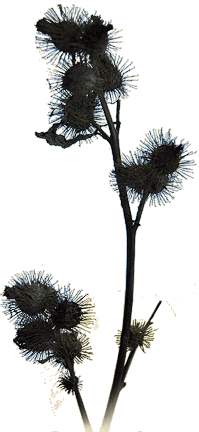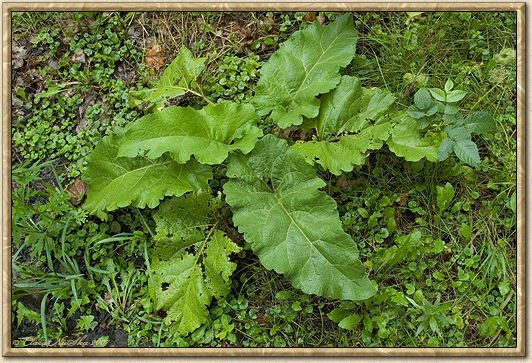|
|
III. The Indispensable Oil Remedy.
In addition to water, the body needs oil. Burdock increases the bile secretion to digest oily foods better, increases oil uptake and liver processing of lipids, and distributes lipids to the skin, hair, tissues, adrenals, and steroids and hormonal system.
Arctium lappa. Burdock.
One would expect burdock to have a long history of use in medicine, but a review of traditional literature shows that it was little used until the eighteenth century, when it starts its career as a diuretic and “blood purifier.” Some specific indications are found in the eclectic literature in the nineteenth century, but it was not widely used until the twentieth, when it finally appears in many formulations – still as an alterative or blood purifier. As far as I know, the use of burdock as a specific, and the accumulation of a list of specific indications, have awaited my own hand. Burdock is a member of the asteraceae. It contains lignans, bitter priniciples, inulin (starch), mucilage, sugars, pectin, minerals including sulphur, and organic acids.
|
 |
 |
Burdock root is bitter, sweet, and oily. It is therefore well suited to dry/atrophic conditions where there is a need to increase secretions, tissue feeding, and tissue cleansing. The bitters stimulate secretion in the digestive tract. The oils increase secretion of bile, promoting better absorption of fats and oils through the small intestine, better activity of the gallbladder, and increased processing of oils by the liver. Burdock root is called for when there is poor secretion of bile, indicated by dry stool and constipation and poor emulsification of fats and oils. With low absorption of lipids there is a shortage of these substances around the body. Burdock is thus associated with dry, scaly skin conditions and dry skin in general. Sometimes the sebaceous glands get blocked, due to a lack of oil moving through them, resulting in inflammation – hence the association of burdock with acne and boils. The sinuses and lungs are also dry and the secretion through the kidneys is limited.
Burdock seed is more diuretic and diffusive. It is particularly used when the skin and kidneys are involved. It is suited to “affection of the kidneys, such as atrophy or wasting away,” writes Richard Hool (1922, 17). This occurs with dry tissues, though there are local areas of water retention – edema. “When the water cannot move, some of it gets stuck,” comments Phyllis Light. “The virtue is diuretic,” proclaims John Hill (1840, 97), “and is very powerfully so. It has cured dropsies alone.” Samuel Henry (1814, 63) calls burdock root “diuretica mundificans.”
Henry also recommended burdock root highly in syphilis, a condition for which it was long used. “For the benefit of our poor gallant, but unfortunate seamen, &c. I shall reveal my celebrated antivenereal remedy, by the use of which I have cured numbers both in its recent and fourth stage, without the use of mercury.” Burdock root, one pound; yellow dock root half a pound; yarrow half a pound; parsley roots and leaves half a pound; comfrey four ounces. Boil in eight quarts of water, down to one gallon. “When it is to be carried to sea in warm weather” add gin. A gill to be taken three times a day.
The liver is also affected. With a lack of fats and oils, there is reduced anabolism of lipids for the body to use, with wasting and dryness. In order to get nutrition there may be dependence on “quick fixes” of sugar. Thus, it is a remedy for sugar imbalances. Since steroid and sex hormones are made from oil and require oil for transmission through the body, and all hormones of any kind require adequate fluids for movement, burdock comes up as something of an endocrine and female remedy.
Burdock has a powerful action on the skin. This is attributed to its influence on the liver and blood. Here is a case history from Derby herbalist George Slack (1919, 107). “The author ounce cured a man who was suffering from boils and abscesses nearly all over his body with burdock and yarrow made into a strong decoction, and drunk freely. He had been ill five months, and was given up to die; but in one month he was restored.” Here is another case history from Lise Wolff, registered herbalist (AHG), of Minneapolis. A three and a half year old girl, diagnosed with ichthyosis. The skin was flaking off all over the body in large patches and was dry, hot, and red. If she got hot the skin became red and peeled off. Fever turned the skin bright red. She would get cranky and irritable when it itched and couldn’t sleep at night. Healthy birth, no medications, no antibiotics. Chamomilla (for the attitude) 2 drops, Arctium radix, 2 drops, Salvia officinalis, 2 drops; 3 times a day. Two months later the skin is slightly flakey, in fine, small flakes, the hands are still inflamed, sleeps fine, less irritable.
Dorothy Hall (1988) recommends burdock for conditions where the skin is broken open and weeping an exudate, but I would still maintain that this is in cases that are intrinsically dry – the weeping is due to water that can’t get out through the skin and kidneys in the healthy fashion.
Burdock, with its brown, fur-like burs, would be classified in American Indian medicine as a ‘bear medicine.’ Indeed, such an application in ancient Eurasia is indicated by the name arctium, from the Greek arctos (bear). The oily bear medicines usually stimulate the gallbladder, liver, thyroid and adrenal cortical functions, encouraging the digestion and metabolism of fats and proteins. The metabolism of the bear, which swings greatly from winter hibernation to summer feeding, is dependent on these organs for storage and utilization of fats and proteins.
David Hoffmann (2004, 528) uses an arresting expression in his discussion of burdock. It will “move the body to a state of integration and health.” Burdock helps to restore the primal blueprint of health, so to speak, when it has been lost in persons suffering from long, chronic illness. It was thus once an important remedy for syphilis, a disease which attacks the basic integrative forces of life, the primal essence, or genetic material, and the hard and supportive structures of the body.
Taste: (root) sweet, bitter, pungent • warm • oily
(seed) bitter, pungent, sweet • warm • diffusive.
Tissue State: atrophy, stagnation

Specific Indications
Constitution, complexion, characteristic symptoms
– Heat, dryness, lack of oil.
– Thin, withered persons with dry skin and scalp.
– Emotionally stoic; phlegmatic about pain.
– Tired, worn-out, worried.Head
– Dry scalp with red, scaly patches and hair loss.
– Headache, frontal, with dry sinus.
Respiration
– Respiratory conditions with dry mucosa; allergies, sinusitis, bronchitis.
Digestion, Liver, and Gallbladder
– Lack of secretion in the upper gastrointestinal (seed).
– Lack of lubrication in the lower gastrointestinal; constipation (root).
– Poor glandular function; lymphatics, pancreas, endocrine, prostate, liver, spleen.
– Liver and gallbladder congestion; gallstones.
– Blood sugar lability.
Female
– Uterine prolapse; with tired feet.
– Pregnancy: balancing and nutritive during; helps prevent water retention and jaundice in babies.
Male
– Specific for swollen prostate in men who lift weights incorrectly.
Kidneys and Bladder
– Leeches out concretions, kidney stones, arthritis.
– Edema.
Muscular and Skeletal
– Arthritis, bursitis; better from movement; worse when immobilized.
– Lower part of spine stiff.
– Sciatica; unbearable at night.
– Gouty pain.
– Better from movement, exercise, bending, open air; worse from inactivity, closed, warm room.
– Carpal tunnel syndrome.
Fever
– Fever with excessive oily sweating and worry.
Skin
– Profuse underarm sweat.
– Dry or oily skin, acne, eczema, dandruff; boils, abscesses, poison ivy, rashes, itching, measles (leaf externally).
– Retention of water in persons who are generally dry; swelling in the upper thighs and
across the belly and the upper eyelids, with bags under the eyes, absence of perspiration,
the skin is trying to conserve water.
– Pulse thin.
– Boils, abscesses, carbuncles.
– Single large pimples that are not coming to a head at the surface.
Preparation and dosage:
The root is used for chronic conditions, the seed (or fructs, actually) in acute. A biennial, the roots are dug at the end of the first year or the beginning of the second. The seeds are harvested just after the end of the second year, before the plant is completely dead. The leaves are sometimes used externally as a poultice. The roots, high in oils, easily go rancid and need to be dried with artificial heat and left in the open air. They extract well in alcohol. Brandy brings out the nice bittersweet flavor. Dose: 3-60 drops, 1-3x/day. The dried root and seeds may be used by decoction as a tea. One teaspoon of ground root to one cup of boiling water.
Cautions:
Widely used as a food. May cause allergic reactions in a few people allergic to asteraceae plants. Has caused skin outbreaks in some people; perhaps a cleansing effect.
Literature:
Traditional (8, 9, 13, 17, 20, 26, 29), Nicholas Culpeper (13), Jack Ritchason (14), John King, John Hill (16), William Boericke (13, 20), Dorothy Hall (3, 13, 18-22), Cyril Boger (1, 24), Matthew Wood (3, 4, 5, 28, 30), Julia Graves (30), Lise Wolff (6, 7, 13), Phyllis Light (10, 12, 16, 27), Margi Flint (14), Harvey Felter (2).
Selections from The Earthwise Herbal
By Matthew Wood M.Sc. (Herbal Medicine)
Registered Herbalist (AHG)
To be published by North Atlantic Books, in two volumes, 2008-9
"In a busy practice covering over twenty five years and tens of thousands of clients, a person learns what remedies are of invaluable service. I would like to share my selection – herbs I choose and herbs that choose me."
|
|